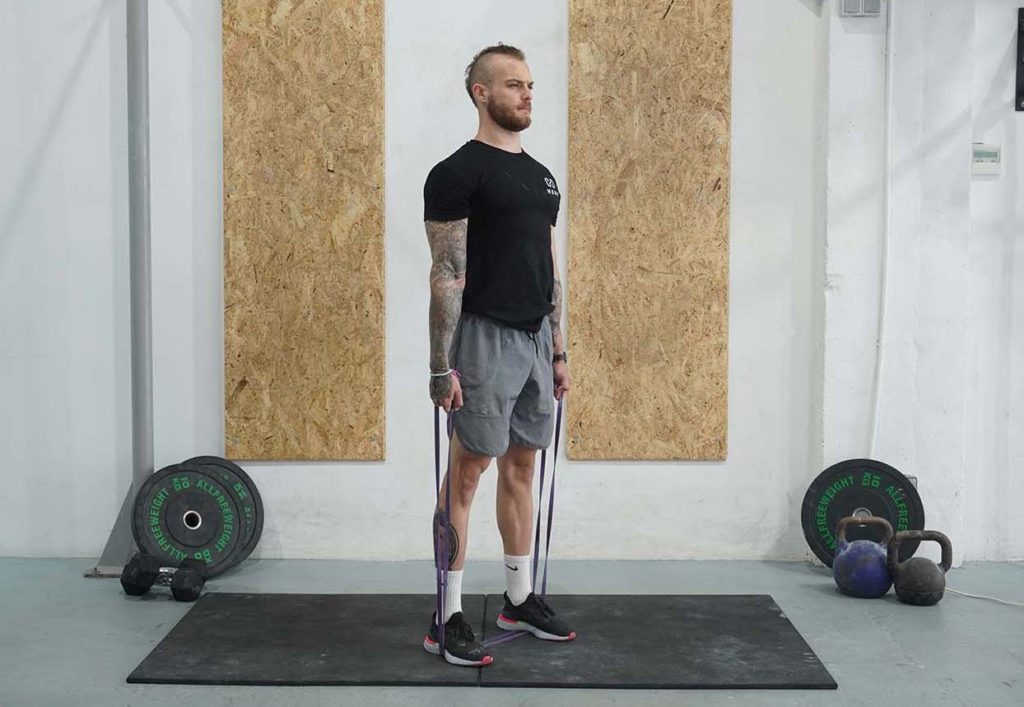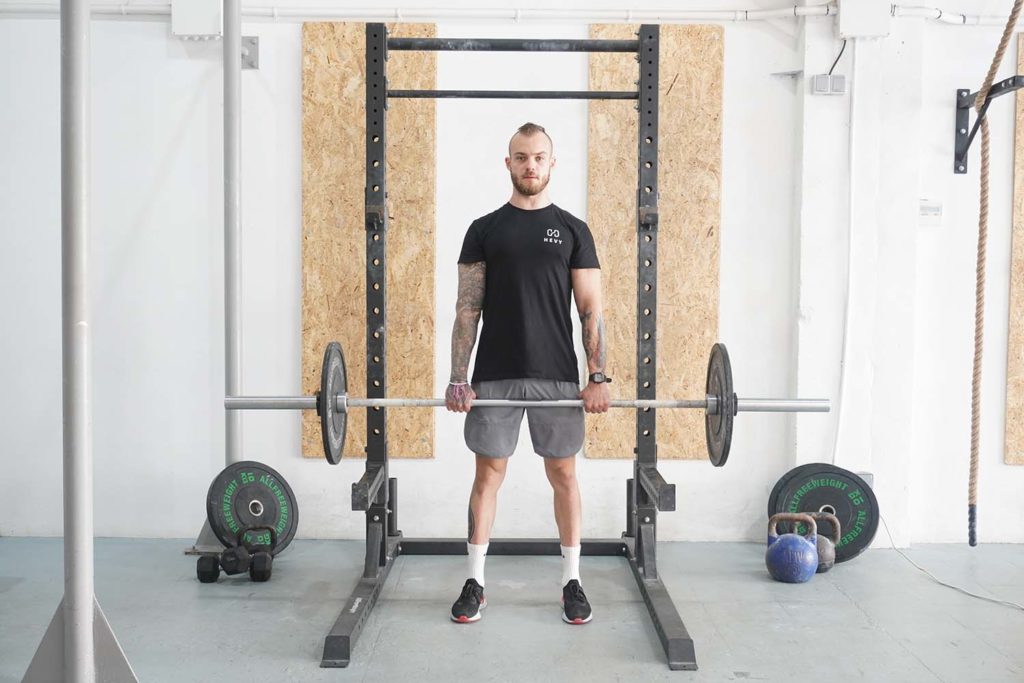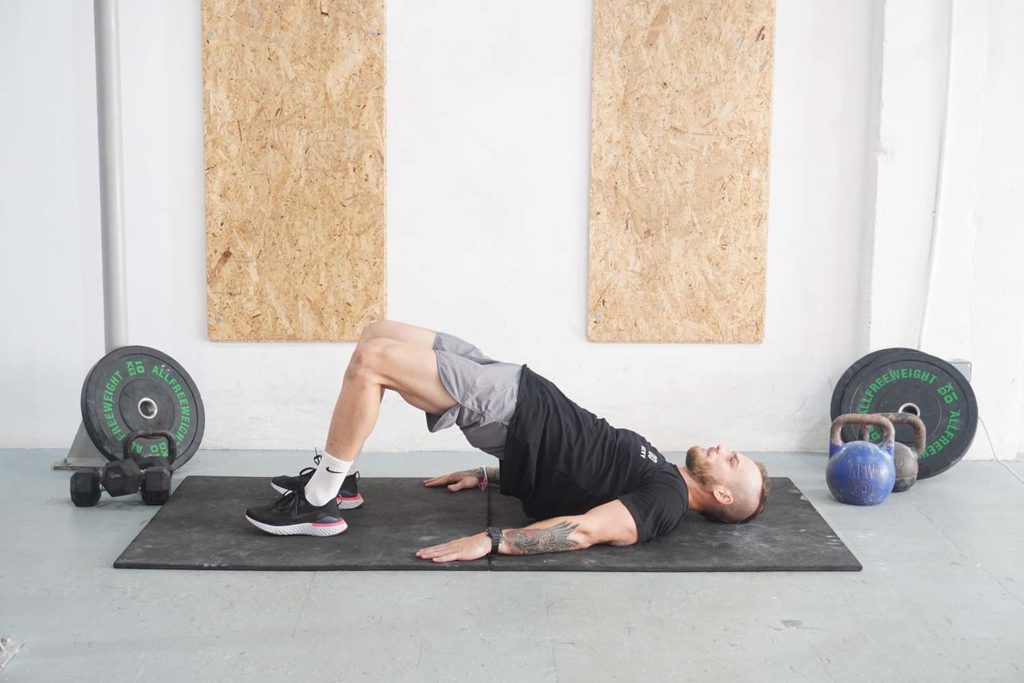The Deadlift with a Band is a Highly Portable Leg Exercise
Not everyone can (or wants to) deadlift a barbell. For example, some people don’t have access to a barbell because they are training at home. Luckily, deadlifts with a band are a practical alternative for everyone who wants to do the exercise but doesn’t have access to much equipment.
Deadlifts with a band train the same muscles through a similar range of motion, build strength, and improve your athletic performance. The best part is that you can do the exercise anywhere, so long as you have a band.
Deadlifting strengthens your back, develops your hip extensors (glutes and hamstrings), builds your quadriceps, and improves overall stability and strength. As a result, your athletic abilities improve, and everyday tasks become more accessible.
The deadlift is a highly technical exercise, so we recommend doing it earlier in your workouts to prevent poor technique due to fatigue.
How to do a Deadlift with a Band

- Take a long resistance band with handles and step over it with both feet. Your feet should be about hip-width apart.
- Grab both handles evenly and stand tall. There should be a fair amount of tension in the resistance band.
- Bring your shoulders back, direct your gaze forward, and engage your abs and glutes.
- Take a breath and begin to lower your torso by bringing your butt back while keeping your shoulders back and spine in a neutral position. Your head should be in line with your torso.
- Once you’ve lowered yourself a bit, also begin to bend your knees to get yourself to the bottom position.
- Deadlift with the resistance band by extending your hips forward and simultaneously straightening your knees. Keep your back in a neutral position.
- Once you’re standing straight, take another breath and repeat.
What muscles does a deadlift with a band activate?
The primary muscle groups that work during a deadlift are the glutes and hamstrings (1). Both muscle groups produce hip extension, which occurs as we deadlift. Our glutes are the primary muscle group that works, and our hamstrings assist and contribute to knee stability.
Similarly, the quadriceps play a role during a deadlift (1). The muscle group covers the front of our thighs, producing knee extension, allowing us to stand up during a deadlift (2).
The entire back musculature also works during a deadlift (1). Many muscles (including the trapezius, erector spinae, infraspinatus, and rhomboids) flex isometrically, providing torso stability. Our latissimus dorsi play a more active role because they help us bring our arms to our torso as we stand up during a deadlift.
The entire midsection (rectus abdominis, transverse abdominis, and obliques) also activates during deadlifts to provide stability.
Tips on Proper Form when Performing a Deadlift with a Resistance Band
Using proper technique when deadlifting is important for two reasons. First, it keeps your spine in a healthy position, reducing the risk of injuries. Second, it allows you to activate the correct muscles and get the most out of every repetition.
A vital tip to keep in mind for deadlifts with a band is finding the correct tension level. You have to step over a band, grab it, and feel some tension at the bottom. As you deadlift, the tension should increase enough to provide a challenge near the top of every repetition.

Maintaining tension through your midsection is also essential, as doing so allows you to stay stable, produce more force, and train with greater resistance. Take a deep breath and brace your abs before every repetition.
Deadlifting from the correct position is also important for engaging the right muscles. Your hips should be slightly lower than your shoulders, with your knees bent to some degree. Don’t start repetitions with straight legs, and avoid squatting off the bottom by having your hips too low at the start.
Variations and Modifications of the Deadlift with a Band
1. Romanian Band Deadlift
The Romanian band deadlift is a fantastic exercise for emphasizing your hamstrings, the muscles covering the back of your thighs (3). Unlike standard deadlifts, Romanian deadlifts start from the top position. You must hinge at the hip and lean your torso forward as you keep your knees almost straight.
2. Sumo Band Deadlift
The sumo band deadlift is a variation where you assume a much wider stance. Due to the position, sumo deadlifts allow more knee flexion and a more upright torso, resulting in less hip extension. As such, sumo deadlifts more effectively emphasize your quadriceps and adductors (inner thigh muscles) (4).
3. Pause Band Deadlift
Pause band deadlifts are a variation you can perform to improve your strength off the bottom and increase muscle activation in your hamstrings, glutes, and back. The objective is to initiate the deadlift variation but pause for a second or two and then complete the repetition.
Mistakes to Avoid
One of the most common mistakes with deadlifts is rounding your lower back. Doing so can place unnecessary stress on your spine, increasing the risk of injuries. Avoid the mistake by bringing your shoulders back as you set up for the deadlift. You can also film some of your sets or look at yourself in the mirror to ensure a neutral spine.
The second common error with deadlifts is an incorrect hip position. Trainees often position their hips too high or too low. The elevated hip position turns the exercise into a stiff-legged deadlift, shifting the emphasis on your hamstrings. In contrast, a low hip position emphasizes your quadriceps by turning the deadlift into a squat. The ideal hip height is to set up as you maintain a slight bend in your knees, and your hips should be slightly lower than your shoulders.
The third significant mistake to avoid is not using a full range of motion. A deadlift starts at the ground and ends there, but too many trainees shorten the range of motion, only doing the middle part. A shorter range of motion makes each repetition less effective and prevents you from training your glutes, hamstrings, and quadriceps effectively. Take your time to set up correctly, extend your hips at the top, and end each repetition near the floor.
Similar Exercises to the Deadlift with a Band
Rack Pull

Rack pulls are a modified deadlift. The goal is to elevate a barbell on a rack or blocks and pull from an elevated position. Doing so is beneficial for emphasizing your back without putting much stress on your legs.
Glute Bridge

Like deadlifts with a band, the glute bridge is an effective exercise that strengthens your hamstrings, glutes, and lower back (5). The goal is to lie on the floor, bend your knees, and plant your feet on the floor. Once in position, extend your hips to the ceiling as you contract your posterior muscles.

